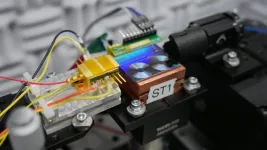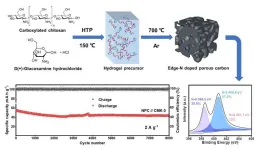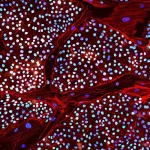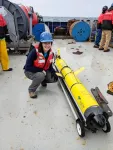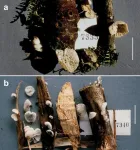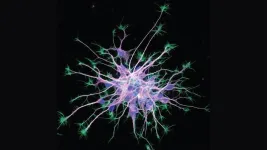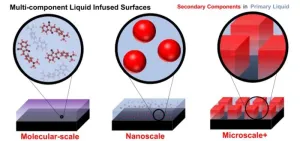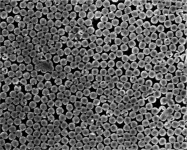(Press-News.org) The National Institute of Standards and Technology (NIST) and its collaborators have delivered a small but mighty advancement in timing technology: compact chips that seamlessly convert light into microwaves. This chip could improve GPS, the quality of phone and internet connections, the accuracy of radar and sensing systems, and other technologies that rely on high-precision timing and communication.
This technology reduces something known as timing jitter, which is small, random changes in the timing of microwave signals. Similar to when a musician is trying to keep a steady beat in music, the timing of these signals can sometimes waver a bit. The researchers have reduced these timing wavers to a very small fraction of a second — 15 femtoseconds to be exact, a big improvement over traditional microwave sources — making the signals much more stable and precise in ways that could increase radar sensitivity, the accuracy of analog-to-digital converters and the clarity of astronomical images captured by groups of telescopes.
The team's results were published in Nature.
Shining a Light on Microwaves
What sets this demonstration apart is the compact design of the components that produce these signals. For the first time, researchers have taken what was once a tabletop-size system and shrunken much of it into a compact chip, about the same size as a digital camera memory card. Reducing timing jitter on a small scale reduces power usage and makes it more usable in everyday devices.
Right now, several of the components for this technology are located outside of the chip, as researchers test their effectiveness. The ultimate goal of this project is to integrate all the different parts, such as lasers, modulators, detectors and optical amplifiers, onto a single chip.
By integrating all the components onto a single chip, the team could reduce both the size and power consumption of the system. This means it could be easily incorporated into small devices without requiring lots of energy and specialized training.
“The current technology takes several labs and many Ph.D.s to make microwave signals happen,” said Frank Quinlan, NIST physical scientist. “A lot of what this research is about is how we utilize the advantages of optical signals by shrinking the size of components and making everything more accessible.”
To accomplish this, researchers use a semiconductor laser, which acts as a very steady flashlight. They direct the light from the laser into a tiny mirror box called a reference cavity, which is like a miniature room where light bounces around. Inside this cavity, some light frequencies are matched to the size of the cavity so that the peaks and valleys of the light waves fit perfectly between the walls. This causes the light to build up power in those frequencies, which is used to keep the laser’s frequency stable. The stable light is then converted into microwaves using a device called a frequency comb, which changes high-frequency light into lower-pitched microwave signals. These precise microwaves are crucial for technologies like navigation systems, communication networks and radar because they provide accurate timing and synchronization.
“The goal is to make all these parts work together effectively on a single platform, which would greatly reduce the loss of signals and remove the need for extra technology,” said Quinlan. “Phase one of this project was to show that all these individual pieces work together. Phase two is putting them together on the chip.”
In navigation systems such as GPS, the precise timing of signals is essential for determining location. In communication networks, such as mobile phone and internet systems, accurate timing and synchronization of multiple signals ensure that data is transmitted and received correctly.
For example, synchronizing signals is important for busy cell networks to handle multiple phone calls. This precise alignment of signals in time enables the cell network to organize and manage the transmission and reception of data from multiple devices, like your cellphone. This ensures that multiple phone calls can be carried over the network simultaneously without experiencing significant delays or drops.
In radar, which is used for detecting objects like airplanes and weather patterns, precise timing is crucial for accurately measuring how long it takes for signals to bounce back.
“There are all sorts of applications for this technology. For instance, astronomers who are imaging distant astronomical objects, like black holes, need really low-noise signals and clock synchronization,” said Quinlan. “And this project helps get those low noise signals out of the lab, and into the hands of radar technicians, of astronomers, of environmental scientists, of all these different fields, to increase their sensitivity and ability to measure new things.”
Working Together Toward a Shared Goal
Creating this type of technological advancement is not done alone. Researchers from the University of Colorado Boulder, the NASA Jet Propulsion Laboratory, California Institute of Technology, the University of California Santa Barbara, the University of Virginia, and Yale University came together to accomplish this shared goal: to revolutionize how we harness light and microwaves for practical applications.
“I like to compare our research to a construction project. There’s a lot of moving parts, and you need to make sure everyone is coordinated so the plumber and electrician are showing up at the right time in the project,” said Quinlan. “We all work together really well to keep things moving forward.”
This collaborative effort underscores the importance of interdisciplinary research in driving technological progress, Quinlan said.
Paper: Igor Kudelin et al. Photonic chip-based low noise microwave oscillator. Nature. Published online March 6, 2024. DOI: 10.1038/s41586-024-07058-z
END
Shrinking technology, expanding horizons
Compact chips advance precision timing for communications, navigation and other applications
2024-03-06
ELSE PRESS RELEASES FROM THIS DATE:
Edge-nitrogen doped porous carbon for energy-storage potassium-ion hybrid capacitors
2024-03-06
They published their work on March. 4th in Energy Material Advances, a Science Partner Journal (https://spj.science.org/journal/energymatadv).
"The development of cost-effective and high-performance electrochemical energy storage devices is imperative," said paper's corresponding author Wei Chen, a professor in the School of Chemistry and Materials Science, University of Science and Technology of China (USTC). "Currently, lithium-ion batteries still dominate the market, but they are limited in both lithium as a resource and in their power densities."
Chen ...
Revolutionary elephant iPSC milestone reached in Colossal’s Woolly Mammoth Project
2024-03-06
Dallas, TX – March 06, 2024 - Colossal Biosciences (“Colossal”), the world’s first de-extinction company, announces today that their Woolly Mammoth team has achieved a global-first iPSC (induced pluripotent stem cells) breakthrough. This milestone advancement was one of the primary early goals of the mammoth project, and supports the feasibility of future multiplex ex utero mammoth gestation.
iPSC cells represent a single cell source that can propagate indefinitely and give rise to every other type of cell in a body. As such, the progress with elephant iPSCs extends far beyond ...
JAMA study finds facilities treating poor patients penalized by CMS payment model
2024-03-06
INDIANAPOLIS – A new study of more than 2,000 dialysis facilities randomized to a new Medicare payment model aimed to improve outcomes for patients with end-stage kidney disease has found that facilities that disproportionately serve populations with high social risk have lower use of home dialysis and transplant waitlisting and fewer kidney transplants. These facilities thus received reduced performance scores and reimbursement from Medicare.
A high proportion of non-Hispanic Blacks and of those initiating dialysis while uninsured or Medicaid-covered also was found to be an indicator of lower use of home dialysis and transplant waitlisting and fewer kidney ...
For Boston College professor, research into "high latitude" reaches of the seas led to improving accurate access to real-time ocean data
2024-03-06
Chestnut Hill, Mass (03/06/2024) – Boston College Assistant Professor of Earth and Environmental Sciences Hilary Palevsky has been awarded a nearly $1-million National Science Foundation CAREER Award for her work to make remote ocean monitoring data accessible and accurate in real time and produce a series of educational videos to guide students using the data.
Palevsky, whose research focuses on marine biogeochemistry and the mechanisms that enable the ocean to absorb carbon dioxide from the atmosphere, said the funding will allow her to build upon the work she has done to help scientists use the ...
Microbes impact coral bleaching susceptibility, new study shows
2024-03-06
Washington, D.C. – March 6, 2024 – A new study provides insights into the role of microbes and their interaction as drivers of interspecific differences in coral thermal bleaching. The study was published this week in Applied and Environmental Microbiology, a journal of the American Society for Microbiology.
“The diversity, community dynamic and interaction of coral associated microorganisms play important roles in the health state and climate change response pattern of coral reefs,” said lead study author Biao ...
Study: Black boys are less likely to be identified for special education when matched with Black teachers
2024-03-06
WASHINGTON, March 6, 2024—Black male elementary school students matched to Black teachers are less likely to be identified for special education services, according to new research published today. The relationship is strongest for economically disadvantaged students. The study, by Cassandra Hart at the University of California, Davis, and Constance Lindsay at the University of North Carolina at Chapel Hill appeared in the American Educational Research Journal, a peer-reviewed journal of the American Educational Research Association.
The researchers also found that the connection is ...
A new genus of fungi on grasses
2024-03-06
While ecologically important, small mushrooms on monocots (grasses and sedges) are rarely studied and a lack of information about their habitat and DNA sequences creates difficulties in determining their presence or absence in ecological studies and their genetic relationships to other mushroom taxa.
This study led by Drs. Karen W. Hughes and Ronald H. Petersen (University of Tennessee, Knoxville, TN, USA) examined a mushroom species, Campanella subdendrophora, (also known as Tetrapyrgos subdendrophora), which fruits on grasses in the US Pacific Northwest.
The researchers evaluated its phylogenetic position concerning both Campanella and Tetrapyrgos ...
Allen Institute joins the Weill Neurohub
2024-03-06
SEATTLE, WASH.—March 6, 2024—The Allen Institute has officially become the newest member of the Weill Neurohub, a collaborative research network advancing treatments for neurological diseases.
Founded in 2003 by philanthropist Paul G. Allen, the Allen Institute focuses on big questions in biology through a team-based, open science approach, and currently has moonshot projects in neuroscience, cell biology, and immunology institutes.
The new partnership will integrate the Allen Institute’s expertise ...
Revolutionizing surface technology: Introducing multi-component liquid-infused surfaces for adaptive and functional coatings
2024-03-06
Surface coatings have long been essential in various industries, offering protection and functionality. In recent years, liquid-infused surfaces (LIS) have emerged as a groundbreaking technology, revolutionizing how we approach surface coatings. In a review article recently published in Industrial Chemistry & Materials on Feb. 23, 2024, authors Zachary Applebee and Dr. Caitlin Howell explore a novel approach in surface technology that could significantly impact various industries, including healthcare and environmental conservation. A new frontier is emerging: multi-component ...
Nanodevices can produce energy from evaporating tap or seawater
2024-03-06
Evaporation is a natural process so ubiquitous that most of us take it for granted. In fact, roughly half of the solar energy that reaches the earth drives evaporative processes. Since 2017, researchers have been working to harness the energy potential of evaporation via the hydrovoltaic (HV) effect, which allows electricity to be harvested when fluid is passed over the charged surface of a nanoscale device. Evaporation establishes a continuous flow within nanochannels inside these devices, which act as passive pumping mechanisms. This effect is also seen in the microcapillaries of plants, where ...
LAST 30 PRESS RELEASES:
Membrane magic: FAMU-FSU researchers repurpose fuel cells membranes for new applications
UN Member States pledge to increase access to diagnosis and inhaled medicines for the 480 million people living with COPD
Combination therapy shows potential to treat pediatric brain cancer ATRT
Study links seabird nesting to shark turf wars in Hawai‘i
Legal sports betting linked to sharp increases in violent crime, study finds
Breakthrough AI from NYUAD speeds up discovery of life-supporting microbes
New Eva Mayr-Stihl Foundation funding initiative boosts research at University of Freiburg on adaptation of forests to global change
The perfect plastic? Plant-based, fully saltwater degradable, zero microplastics
Bias in data may be blocking AI’s potential to combat antibiotic resistance
Article-level metrics would provide more recognition to most researchers than journal-level metrics
Satiety’s little helper: Protein that supports appetite regulating protein identified
UF dives deep into predicting storm damage with computer models
A stormy ocean voyage yields insights on the global carbon cycle
Scientists identify first non-coding gene that controls cell size
Demonstration of altermagnetism in RuO₂ thin films -- A new magnetic material for the AI era
Penn researchers awarded $25M to conduct trial using smartphones to fight heart disease
PCORI awards funding for new patient-centered healthcare research
Exploring the origins of the universe: 145 low-noise amplifiers complete ALMA telescopes
Empress cicada wings help illuminate molecular structure
Using sound waves to detect helium
Time burden in patients with metastatic breast and ovarian cancer from clinic and home demands
Researchers discover bias in AI models that analyze pathology samples
Scientists ID potential way to prevent brain injuries from triggering Alzheimer's
MASTER 2nd Open Call: Execution period kick-off
Algae for health in food and pharma
Advanced microrobots driven by acoustic and magnetic fields for biomedical applications
Chicago health information leader recognized for raising CPR readiness and blood pressure awareness
The Intimate Animal, a new book from Kinsey Institute Executive Director Dr. Justin Garcia
When blue-collar workers lose union protection, they try self-employment
New video dataset to advance AI for health care
[Press-News.org] Shrinking technology, expanding horizonsCompact chips advance precision timing for communications, navigation and other applications
